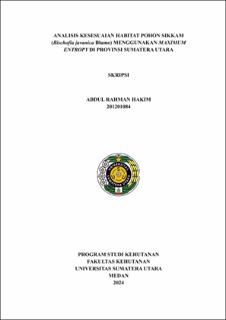Analisis Kesesuaian Habitat Pohon Sikkam (Bischofia javanica Blume) Menggunakan Maximum Entropy di Provinsi Sumatera Utara
Analysis of Suitability Habitat Sikkam Tree (Bischofia javanica Blume) Using Maximum Entropy in North Sumatera Province

Date
2024Author
Hakim, Abdul Rahman
Advisor(s)
Rambey, Ridahati
Saputra, M Hadi
Metadata
Show full item recordAbstract
Sikkam (Bischofia javanica Blume) is a tree in the Euphorbiaceae family that is widespread in Bangladesh, India, Indonesia, China, the Philippines, and Vietnam. Sikkam is used to treat various diseases such as cancer, inflammation, tuberculosis, diarrhea, sore throat, burns and various allergic conditions. The study aims to analyze the suitability of the habitat of the sikkam trees in the North Sumatra Province and to find out the analysis of the vegetation around the octops in the Simalungun district, North Sumatera Province. Field data collection methods are purposive sampling methods and environmental variables used are height maps, slope slope map, aspect map, land cover map, soil type map, and climate data that are then processed using the Maximum Entropy application. Vegetation analysis is performed using plot sizes of 10 x 10 meters. The results of the research showed that the corresponding area has a percentage of 0.83% or 60.624,2 Ha, and the very corresponding region has a percent of 0.65% or 47.734,9 Ha. The highest INP in the village of Bandar Dolok is the Sureni Toona of 82,432%. The most high INP of the Village of Sipolha Horison is the Merkusii Pine of 85,337%. In the village in Pematang Tambun Raya, Three Ras, Sirube-rube of Ancient Mountains, and Parik Sabungan is Bischofia javanica with the INP consecutive of 75,879%, 75,546%, 91,834%, and 54,65%.7 The type diversity index is at a moderate level.
Collections
- Undergraduate Theses [2147]
